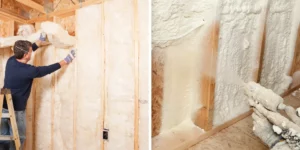There are pros and cons to installing spray foam insulation in your home. Open-cell foam is cheaper than closed-cell foam, but they are both effective in sealing attic vents and are energy efficient. Read this article to learn the differences between them. Homeinsulators.us recommends choosing the right one for your home. Read on to learn about some of the pros and cons of both types of insulation. Whether you choose spray foam insulation for your home or open-cell foam, you’ll be glad you did.
Open-cell foam is cheaper
While fiberglass is cheaper than spray foam, it is not as effective as open-cell insulation. Open-cell spray foam is more effective at blocking sound, but fiberglass insulation is flammable in certain situations. It is also necessary to apply intumescent paint, which provides a 15-minute thermal barrier. Ultimately, the type of insulation you choose will depend on your specific needs and budget. There are two primary types of spray foam: open-cell and closed-cell.
Open-cell spray foam
Open-cell foam costs less than closed-cell foam, but it has a lower R-value. Closed-cell foam is more rigid and expands at a slower rate, and it is heavier. Open-cell spray foam has a lower R-value and is thin and lightweight. The difference isn’t noticeable, but it is worthwhile to consider the differences between the two. The R-value of closed-cell foam is about R-6 to R-7 per inch, depending on the brand and type.
Durability and Insulates
While open-cell spray foam is cheaper, it does not offer the same durability and insulates at extreme temperatures. Whether closed-cell or open-cell, both types of foam should be installed properly. First American Roofing and Siding offers premium insulation applications. You can call us today for a consultation and estimate! So you can make the right decision for your home! We are always happy to help! You’ll love the savings you’ll enjoy!
They both seal attic vents
While spray foam insulation and attic vent sealing may seem like a simple, straightforward process, it’s not. Installed improperly, spray foam insulation can result in moisture and air leakage. While some roofers understand the nuances of this new building science, most aren’t aware of it. Luckily, there are roofers who know more about spray foam insulation than you do. Here are a few things you should know.
High-Quality Insulation
The first step in an attic retrofit is to determine the amount of moisture and air leakage. A single air and vapor barrier on the underside of the ceiling joists are the most common and least expensive approach, but it’s also the least efficient. Spray foam offers both air sealing and an initial layer of high-quality insulation. And since you can top it up to the desired RSI (R) level, attic retrofitting can be done simultaneously with interior renovations.

Installing Spray Foam Insulation And Attic Vent Sealing
After choosing the type of spray foam insulation, you should inspect your attic for mold. If you spot any, you can spray a chemical solution or scrub the area with a scrubber. Then, you should check for proper ventilation, such as soffit, ridge, eyebrow, gable end, and mushroom cap vents. If you have all of these components, you should consider installing spray foam insulation and attic vent sealing.
They are Both Energy-Efficient
While the pros of spray foam and traditional insulation are different, they are both extremely energy-efficient. These materials create better air and thermal barriers than their traditional counterparts, and they make better use of engineered products. As a result, spray foam insulation can reduce the workload of HVAC systems, resulting in lower utility bills and increased comfort. Read on to learn more about the benefits of spray foam and traditional insulation.
Traditional Cellulose or Fiberglass Insulation
While traditional cellulose or fiberglass insulation has numerous benefits, spray foam is far superior. Its lifespan is much longer, which means fewer pieces of insulation are going to end up in landfills. Furthermore, this material helps reduce carbon footprint by reducing the amount of insulation that gets discarded. Because of this, spray foam is a great option for homes with a large energy-inefficient footprint.
Fiberglass or Mineral Wool
While conventional materials such as fiberglass or mineral wool are made from synthetic fibers and are not environmentally friendly, they are extremely effective when it comes to energy efficiency. These products have a low GWP and an extended lifespan, so they can reduce energy bills and keep homes comfortable for longer. Furthermore, spray foam insulation is more affordable than traditional insulation, so it will save you money in the long run.